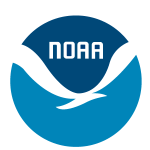- Industrie: Government
- Number of terms: 30456
- Number of blossaries: 0
- Company Profile:
NOAA Coral Reef Conservation Program, National Oceanic and Atmospheric Administration, U.S. Department of Commerce
Group of species considered together, often because they are difficult to differentiate without detailed examination (very similar species) or because data for the separate species are not available (e.g. in fishery statistics or commercial categories).
Industry:Fishing
In stock assessment, the probability of a fish encountering fishing gear (hook, webbing, mesh, trap) and being retained by it after coming in contact with it. Often expressed as a function of size or age.
Industry:Fishing
The largest catch that can be maintained from the population, at whatever level of stock size, over an indefinite period. It will be identical to the sustainable yield for populations below the level giving the maximum sustainable yield (MSY), and equal to the MSY for populations at or above this level.
Industry:Fishing
Those waters between the 30-meter depth contour and the continental shelf break, nominally at about 200 meters depth, and where the salinity is substantially marine (>30 practical salinity units (PSU) throughout the year). Although relatively farther from land than coastal systems, these regions can receive significant runoff influence from land and the water column is in close contact with the bottom relative to oceanic systems.
Industry:Fishing
Schooling fish not associated with the ocean bottom that migrate in coastal waters. They usually eat plankton and are the main food source for higher-level predators such as tuna, salmon, most groundfish, and humans. Examples include herring, squid, sardine, and mackerel.
Industry:Fishing
The size of holes in a fishing net. Minimum mesh sizes are often prescribed by regulations in order to avoid the capture of the young of valuable species before they have reached their optimal size for capture.
Industry:Fishing
PacFIN provides commercial fishery information for Washington, Oregon, and California. Maintained by the Pacific States Marine Fisheries Commission (PSMFC).
Industry:Fishing
Rooted, grasslike flowering plants, such as eelgrass, that are adapted to live at sea, submersed, and can tolerate a saline environment.
Industry:Fishing
The PSMFC is a non-regulatory agency that serves Alaska, California, Idaho, Oregon, and Washington. PSMFC (headquartered in Portland) provides a communication exchange between the Pacific Fishery Management Council and the North Pacific Fishery Management Council, and a mechanism for Federal funding of regional fishery projects. The PSMFC provides information in the form of data services for various fisheries.
Industry:Fishing
The number of fishery recruits (usually age 1 or 2) produced from a given weight of spawners, usually expressed as numbers of recruits per kilogram of mature fish in the stock. This ratio can be computed for each year class and is often used as an index of pre-recruit survival, since a high R/SSB ratio in one year indicates above-average numbers resulting from a given spawning biomass for a particular year class, and vice versa.
Industry:Fishing
